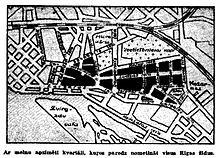Riga ghetto
| Riga Ghetto | |
|---|---|

Riga ghetto, map from Nazi controlled newspaper, summer 1941
|
|
| Also known as | Ghetto Riga, Maskavas Forštate, Moscow Forshtat |
| Location | Riga, Latvia and vicinity, including Rumbula and Biķernieki forests |
| Date | July 1941 to October 1943 |
| Incident type | Imprisonment, mass shootings, forced labor, starvation, exile, forced abortions and sterilization |
| Perpetrators | Hans-Adolf Prützmann, Franz Walter Stahlecker, Hinrich Lohse, Friedrich Jeckeln, Kurt Krause, Eduard Roschmann |
| Organizations | Nazi SS, Arajs Kommando, Latvian Auxiliary Police |
| Camp | Kaiserwald |
| Victims | About 30,000 Latvian Jews and 20,000 German, Czech, and Austrian Jews |
| Survivors | About 1,000 people |
| Memorials | At ruins of Great Choral Synagogue in Riga and in Rumbula and Biķernieki forests |
The Riga Ghetto was a small area in Maskavas Forštate, a neighborhood of Riga, Latvia, designated by the Nazis where Jews from Latvia, and later from Germany, were forced to live during World War II. On October 25, 1941, the Nazis relocated all Jews from Riga and the vicinity to the ghetto while the non-Jewish inhabitants were evicted. Most of the Latvian Jews (about 24,000) were killed on November 30 and December 8, 1941 in the Rumbula massacre. The Nazis transported a large number of German Jews to the ghetto; most of them were later killed in massacres.
While the Riga Ghetto is commonly referred to as a single entity, in fact there were several "ghettos". The first was the large Latvian ghetto. After the Rumbula massacre, the surviving Latvian Jews were concentrated in a smaller area within the original ghetto, which became known as the "small ghetto". The small ghetto was divided into men's and women's sections. The area of the ghetto not allocated to the small ghetto was then reallocated to the Jews being deported from Germany, and became known as the German ghetto.
At the beginning of July, the Nazi occupation regime had organized the burning of the synagogues in Riga, and attempted, with varying degrees of success, to incite the Latvian population into taking murderous action against the Latvian Jewish population. At the end of July, the city administration switched from the German military to German civil administration. The head of the civil administration was a German named Heinz Nachtigall. Other Germans involved with the civil administration included Hinrich Lohse and Otto Drechsler. The Germans issued new decrees at this time to govern the Jews. Under "Regulation One", Jews were banned from public places, including city facilities, parks, and swimming pools. A second regulation required Jews to wear a yellow six-pointed star on their clothing, with violation punishable by death. A Jew was also to be allotted only one-half the food ration of a non-Jew. By August, a German named Altmayer was in charge of Riga. The Nazis then registered all the Jews of Riga. Further decrees mandated that all Jews wear a second yellow star, this one in the middle of their backs, and that they not use the sidewalks. The reason for the second star was so Jews could be readily distinguished in a crowd. Later, when Lithuanian Jews were transported to the ghetto, they were subject to the same two-star rule. Jews could be randomly assaulted with impunity by any non-Jew.
...
Wikipedia
